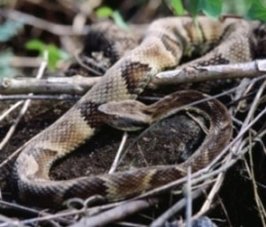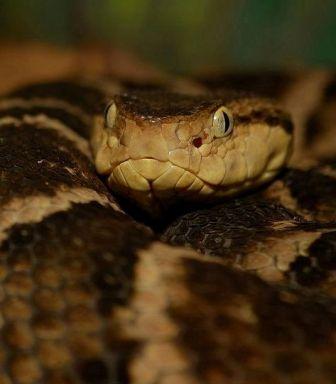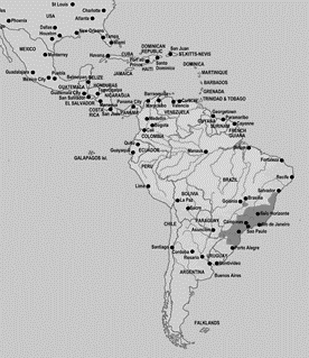JararacaBothrops jararaca |

Custom Search
|
|
The jararaca (Bothrops jararaca) is a venomous pit viper endemic to southeastern South America, the species is abundant and an important cause of snakebite.
They are found in southern Brazil, northeastern Paraguay and Misiones province in northern Argentina It's also found in several islands off the coasts of Argentina and Paraguay, some as far as 35 km offshore. Their specific name, jararaca derives from the joining of 2 Tupi words "yarará" and "ca", which means literally "large snake". Their common name in English is jararaca just like in Portuguese. They are known by many other names in Brazil like jaraca, jaracá, caissaca, jararaca-do-rabo-branco, jararaca-do-campo, jararaca-do-cerrado, jararaca-dormideira, jararaca-dorminhoca and malha-de-sapo. In Paraguay and Argentina it's known as yarará but in Argentina is also known as yararaca or yararaca perezosa. The jararaca preferred habitats include dense evergreen and deciduous tropical forests but are also found in scrub, semi-tropical upland forests, savanna including open regions in cultivated areas usually near vegetation cover. These venomous snakes are most often found under some sort of vegetation cover even when they are basking.The jararaca is often considered a semi-arboreal snake, but adult specimens are mostly terrestrial, while juvenile snakes are more arboreal, probably trying to avoid predators. Even so, the jararaca falls prey to many animals, including mammals such as the white-eared opossum (Didelphis albiventris), other snakes, and birds. When threatened they elevate their head and neck vibrate their tail warning to an imminent strike and they will strike.

The jararaca is a slender and terrestrial snake that grows to a maximum length of about 63 inches (160 cm) but their average size is usually much smaller around 23 inches (60 cm).
These snakes are sexually dimorphic and females are noticeably larger not to mention heavier than males. The jararaca coloration is extremely variable according to the geographical variations in the substrate color, forming a cryptic camouflage, to avoid predators. Usually, their dorsal coloration may be brown, tan, gray, yellow, olive, or almost maroon, overlaid with a series of pale-edged, dark brown somewhat triangular or trapezoidal shaped markings on the sides of the body. These markings reach the vertebral line and may be partially or even completely juxtaposed or situated opposite each other, in most specimens we'll find all 3 variations. Normally their coloration is somewhat lighter in the middle of the body. Very often the juvenile jararacas display a light colored tip on their tails similar to that of young copperheads or cottonmouths. They use it for caudal luring, to lure prey in close. Their life expectancy in the wild is estimated to be around 15 years, they live on average 6.5 years in captivity. Subspecies
There are no subspecies currently recognized for the jararaca. Venom / Bite Their venom is a complex mixture of proteins with different effects like coagulant, proteolytic and hemorrhagic. A peptide found in their venom is used to make drugs for the treatment of hypertension and congestive heart failure. Bites cause swelling at the envenomation site, severe hypotension. blistering, systemic bleeding from skin, gums, and nose, necrosis, and hemorrhagic blebs. In juvenile snakes, the venom has a greater anticoagulant effect than that of adult specimens. A jararaca bite can lead to death due to shock, renal failure, and intracranial hemorrhage. Without treatment, the mortality rate is estimated at 7%, but, with the use of antivenom and other treatments this rate is further reduced. By comparison the venom of their close relative the golden lancehead (Bothrops insularis) is considered to be about 5 times more potent. Diet / Feeding Adult jararacas feed mainly on rodents and birds while juvenile specimens will feed mainly on frogs, centipedes and smaller birds. They also help to control the population numbers of agricultural pests, such as rodents. Like all pit vipers, the jararaca has heat sensing pits located between the eyes and nostrils on both sides of the head. Which enables them to detect their warm-blooded prey while hunting at night. Reproduction In most Viperidae species male to male fighting does occur to establish dominance prior to copulation. However, the jararaca males may be less likely to engage in such behavior since females are much larger than males. Sometimes males will mate with more than one female The jararaca is an ovoviviparous snake species, hatchlings first develop in eggs inside the female but are born live. The mating season occurs between April and May. But females are capable of storing sperm in order to delay fertilization as late as September. Females have one litter per year and are believed to give birth up to 20 young per clutch. After 3 to 4 months of gestation from October through December or January. The hatchlings are born at the beginning of the rainy season between February and April. Females may only reproduce once every two years, depending on food availability since they need plenty to produce the egg yolk. Both jararaca males and females reach sexual maturity at 2 years of age. Conservation / Threats The species has no special conservation status. This jararaca has not yet been assessed for the IUCN Red List, or other agencies, it isn't listed in CITES.
|
Did You Know?
Found in the South American rainforests the green anaconda is, by weight, the largest snake in the world. Scientific classification |
© 2014 Snake Facts About Us | Privacy Policy | Contact




